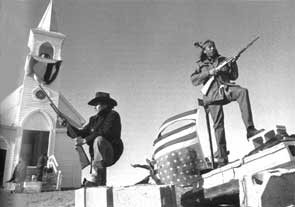Going into the town of Wounded Knee, Joseph Trimbach thought it would be an easy task to end of the occupation. He was entirely wrong. When he told a member of AIM that their only option was to surrender, he was laughed at. Trimbach, shocked, became angry and started to accuse the Indians of "forcibly occupying the village." When the AIM member said the marshals were the invaders because Wounded Knee belonged to the Oglala Lakota, the conversation became heated. Trimbach later stated that, "It soon became apparent that [the AIM member] was getting more excited and I [Trimbach] was getting more nervous." Trimbach decided to end the conversation, as simply giving the Indians the option to surrender was going to do no good. [1] "Scared shitless," according to the AIM member he spoke with, Trimbach called in armed U.S. personnel. [2] By the afternoon of the second day, 250 of them surrounded Wounded Knee. Ironically, This gave the Indians hope; their movement was drawing attention and working the way they had strategically planned.
The U.S. armed personnel weren't the only people to arrive on the second day. Already, the media had arrived. The media, in a sense, was a safe haven for the protesters. This ensured that they would not be attacked because such an unnecessary act of violence by the government could not be viewed by the rest of the nation. Carter Camp told a reporter, "I tell you, if it were not for you people, this government would have slaughtered us as it did in 1890." [3]
"I felt good. This is why AIM was alive. This is why we came to be. Stand up against the FBI. Stand up against the U.S. marshals. Stand up against the Goons, you know, tribal police, and inside we've got freedom. Don't let nobody in." -Dennis Banks (former AIM leader) [4]
With this, the Oglala Lakota's 71 days of "freedom" began.
[1] Dennis Banks and Richard Erdoes, Ojibwa Warrior: Dennis Banks and the Rise of the American Indian Movement (Norman: University of Oklahoma Press, 2004), 169.
[2] Banks and Erdoes, 169.
[3] Banks and Erdoes, 170.
[4] John Kusiak, We Shall Remain: Wounded Knee, DVD, Stanley Nelson (2009: PBS), web.


